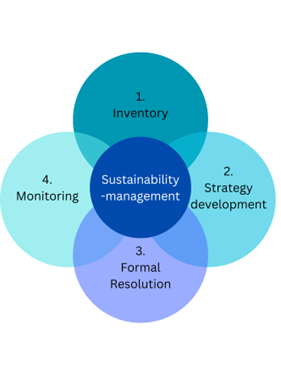Existing customer? Login
Blog
October 15th, 2023
Sustainability Management in Procurement with Procurement Analytics - 4 Simple Steps for Your Procurement Manager
 Eros Vecchio
Eros Vecchio
Sustainability is now a crucial factor for companies to achieve a positive impact on the environment while strengthening their competitiveness. Especially for medium-sized enterprises, promoting sustainable procurement practices and making a positive contribution to environmental protection are becoming increasingly important. An important area where sustainability can be promoted is in procurement. Procurement Analytics enables companies to monitor and assess the sustainability performance of their suppliers. In this article, we will explain how your Procurement Manager can make a positive contribution to environmental protection and achieve your sustainability goals using four simple steps and the assistance of Procurement Analytics.
Challenges so far
Before the introduction of Procurement Analytics, companies often face various challenges when it comes to sustainability management in procurement. One of the biggest challenges is obtaining reliable data and metrics regarding procurement volume to conduct an informed evaluation of the sustainability performance of strategic suppliers in the first step. Manual data collection and analysis are time-consuming and error-prone in practice, making it difficult to identify and promote potential for sustainable procurement practices in the long term.
Furthermore, assessing supplier performance in terms of sustainability is challenging for companies. The supply chain can be complex, and it is often difficult to accurately assess the impact of individual suppliers on the environment and society. This results in companies having limited insights into how they can optimize their procurement and make it more sustainable.
The Solution through Four Simple Steps:
Step 1: Inventory through Analysis of Existing Data:
With Procurement Analytics tools, your Procurement department can conduct a comprehensive data analysis of your procurement volume. This analysis enables data to be collected, cleansed and evaluated. Through the comprehensive database, your Procurement Managers gain valuable insights into supplier performance, resource consumption, and cost structures.
For example, by using SCALUE, procurement managers can conduct an ABC analysis at the supplier, item and category levels. This helps identify key suppliers and items that have a significant impact on procurement performance. In this way, resources can be directed specifically to the most significant procurement aspects in order to effectively pursue sustainability goals.
Furthermore, the analysis of supplier emission behavior is supported. Although the software itself cannot directly map CO2 emissions, it still enables an estimate by looking at the number of deliveries, for example. This allows your procurement managers to indirectly determine the carbon footprint of their supply chain and identify which suppliers contribute significantly to emissions.
Another advantage lies in commodity categorization. By categorizing goods, your company can easily identify which goods are supplied by too many suppliers. Consolidating suppliers for specific categories of goods allows you to increase procurement efficiency and reduce CO2 emissions by minimizing transportation routes.
The comprehensive data analysis, enables your company to create a sound basis for the sustainability strategy in procurement. With the insights gained, you can promote sustainable procurement practices, analyze environmental impacts, measure CO2 emissions, and monitor resource consumption to achieve your sustainability goals and contribute to environmental protection.
Step 2: Independent Strategy Development Based on Acquired Knowledge:
Using insights gained from the analysis, your Procurement leadership can develop their own sustainability strategy. Here, sustainability criteria can be specifically included in supplier selection and evaluation by giving preference to suppliers with good sustainability practices, thereby promoting sustainable procurement practices and helping to improve environmental impact. Internal regulations, such as collective deliveries, also help effectively achieve sustainability goals.

Step 3: Formal Decision by Informing Employees and Suppliers about Sustainability Goals:
Successful implementation of the sustainability strategy requires collaboration from all stakeholders. Therefore, you should inform both your employees and your suppliers about the defined sustainability goals. Transparency and clear communication are crucial for raising awareness of sustainable actions and achieving common goals. After all, only those who work as a team will achieve their goals in the long run.
Step 4: Continuous Monitoring of New Data for Control:
The use of procurement analytics does not end with the implementation of the sustainability strategy. Rather, continuous monitoring of current developments in procurement is essential to ensure that the targeted sustainability goals are achieved. Regular monitoring enables your procurement to identify improvement potentials and further develop sustainable procurement practices. It is important here that the current data is always drawn from your own ERP system(s). The more current and well-maintained the data, the more accurate the analyses. Even with lower-quality data, Procurement Analytics solutions can provide an initial overview and highlight data weaknesses, enabling immediate actions to be taken.
The choice is yours, Procurement can complain about poor data quality for several years, or they can fix the 80% of deficiencies between one and six months.
Would you like to learn more about how SCALUE's solution can help optimize your procurement?
Now you know how to implement your sustainability management easily and effectively. But what other benefits does the use of Procurement Analytics bring to your sustainability management?
1. Transparency and Informed Decisions:
By analyzing procurement data in detail, you gain comprehensive transparency over your procurement processes. This enables informed decisions based on facts and metrics.
2. identification of potential savings:
Sustainable procurement practices often go hand in hand with efficiency increases and cost savings. Procurement Analytics enables the identification of potential savings that can have a positive impact on your company's bottom line.
3. strengthening the corporate image:
Sustainability is increasingly perceived as an important criterion by customers and stakeholders. Through sustainable procurement practices, your entire company can strengthen its image as a responsible player and differentiate itself from the competition.
4. Risk Minimization:
Incorporating sustainability criteria into supplier selection reduces the risk of supply chain disruptions and negative impacts on your company.
Conclusion
The introduction of Procurement Analytics has revolutionized sustainability management in procurement. By strategically utilizing Procurement Analytics, your company can promote sustainable procurement practices, measure environmental impacts, and make a positive contribution to environmental protection. The analysis of environmental impacts, CO2 emissions, and resource consumption allows you to promote sustainable procurement practices and achieve long-term sustainability goals.
Data-driven decision making in procurement is the future for every business. By relying on procurement analytics, your company can not only optimize procurement processes and increase efficiency, but also make a positive contribution to the environment. The combination of efficient procurement and sustainability will help you position yourself as a responsible and competitive company in the long term.

How SCALUE can help you? Schedule a free demo now!
Learn more on our blog: Get More Insights
Follow us on LinkedIn: Get more Content